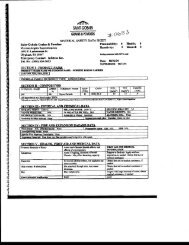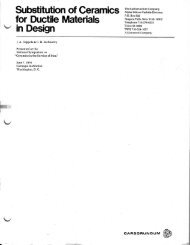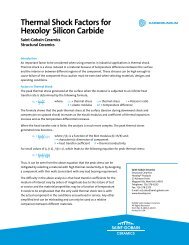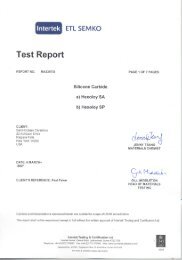Hexoloy® SiC - Material Safety Data Sheets MSDS No. MSDS-434A
Hexoloy® SiC - Material Safety Data Sheets MSDS No. MSDS-434A
Hexoloy® SiC - Material Safety Data Sheets MSDS No. MSDS-434A
Create successful ePaper yourself
Turn your PDF publications into a flip-book with our unique Google optimized e-Paper software.
Hexoloy <strong>SiC</strong> <strong>Material</strong><br />
<strong>Safety</strong> <strong>Data</strong>sheet<br />
Saint-Gobain Ceramics<br />
Structural Ceramics<br />
Chemical Name: Carbides<br />
Section 1 - Chemical Product and Company Identification<br />
Synonyms: SILICON CARBIDE; CARBORUNDUM; CARBON SILICIDE<br />
Manufacturer Information Saint-Gobain<br />
Structural Ceramics Division Phone: (716) 278-6212<br />
23 Acheson Drive Fax: (716) 278-2373<br />
Niagara Falls, NY 14303<br />
Emergency # 1-800-424-9300 (CHEMTREC)<br />
NOTE: CHEMTREC emergency telephone number is to be used in the event of<br />
chemical emergencies involving a spill, leak, fire, exposure, or accident involving<br />
chemicals. All non-emergency questions should be directed to customer service.
Section 2 - Composition / Information on Ingredients<br />
CAS # Component Percent<br />
409-21-2 Silicon carbide 99-100<br />
Component Information/Information on <strong>No</strong>n-Hazardous Components<br />
Remaining components not determined hazardous and/or hazardous<br />
components present at less than 1% (0.1% for carcinogens).<br />
This product is considered hazardous under 29 CFR 1910.1200 (Hazard<br />
Communication).
Section 3 - Hazards Identification<br />
Emergency Overview<br />
This is a non-combustible, non-reactive solid material. Exposure to dust<br />
may cause skin, eye and respiratory tract irritation.<br />
Potential Health Effects: Eyes<br />
Dusts from grinding may cause slight to moderate irritation with redness and pain.<br />
Potential Health Effects: Skin<br />
Chips and dusts from cutting and/or grinding may cause slight irritation by abrasion.<br />
Potential Health Effects: Ingestion<br />
Ingestion of this product is unlikely. However, ingestion of product may<br />
produce gastrointestinal irritation and disturbances.<br />
Potential Health Effects: Inhalation<br />
Inhalation of dusts produced during cutting, grinding or sanding of this<br />
product may cause irritation of the respiratory tract.<br />
HMIS Ratings: Health: 1 Fire: 1 Reactivity: 0 Pers. Prot.: safety glasses, gloves<br />
Hazard Scale: 0 = Minimal 1 = Slight 2 = Moderate 3 = Serious 4 = Severe * =<br />
Chronic hazard
Section 4 - First Aid Measures<br />
First Aid: Eyes<br />
Immediately flush eyes with water for at least 15 minutes, while holding<br />
eyelids open. Do not rub eyes. If irritation persists get medical attention.<br />
First Aid: Skin<br />
If skin becomes irritated, remove contaminated clothing. Wash area of<br />
contact thoroughly with soap and water. Do not rub or scratch exposed<br />
skin. If irritation persists, get medical attention.<br />
First Aid: Ingestion<br />
If the material is swallowed, get immediate medical attention or advice.<br />
Ingestion may cause transient irritation of throat, stomach and<br />
gastrointestinal tract.<br />
First Aid: Inhalation<br />
If inhaled, immediately remove the affected person to fresh air. Seek<br />
medical attention. If breathing is difficult, give oxygen.<br />
First Aid: <strong>No</strong>tes to Physician<br />
<strong>No</strong>ne.
Section 5 - Fire Fighting Measures<br />
Flash Point: <strong>No</strong>t available<br />
Upper Flammable Limit (UFL): <strong>No</strong>t available<br />
Auto Ignition: <strong>No</strong>t available<br />
Rate of Burning: <strong>No</strong>t available<br />
Method Used: <strong>No</strong>t available<br />
Lower Flammable Limit (LFL): <strong>No</strong>t available<br />
Flammability Classification: <strong>No</strong>n-combustible Solid<br />
General Fire Hazards<br />
This material is not expected to be a fire hazard.<br />
Hazardous Combustion Products<br />
Oxides of silicon and carbon may be produced.<br />
Extinguishing Media<br />
Use methods for the surrounding fire.<br />
Fire Fighting Equipment/Instructions<br />
Firefighters should wear full protective clothing including self contained breathing apparatus.<br />
NFPA Ratings: Health: 1 Fire: 1 Reactivity: 0 Other:<br />
Hazard Scale: 0 = Minimal 1 = Slight 2 = Moderate 3 = Serious 4 = Severe
Section 6 - Accidental Release Measures<br />
Containment Procedures<br />
Contain by any means necessary. Block any potential routes to water systems.<br />
Clean-Up Procedures<br />
Wear appropriate protective equipment and clothing during clean-up. Avoid<br />
the generation of dusts during clean-up.<br />
Evacuation Procedures<br />
Follow established emergency procedures.<br />
Special Procedures<br />
Follow all Local, State, Federal and Provincial regulations for disposal.
Section 7 - Handling and Storage<br />
Handling Procedures<br />
Avoid breathing dusts from this material. Avoid contact with skin and eyes.<br />
Wash thoroughly after handling. Keep formation of airborne dusts to a<br />
minimum. Use this product with adequate ventilation.<br />
Components should be packaged for transport with sufficient protection<br />
from chipping or fracture by impact. Take precautions in handling to prevent<br />
damage by impact. Fractured material may have razor sharp edges. Use a<br />
wet brick saw or wet grinder for cutting or grinding of product.<br />
Storage Procedures<br />
Product packaging may contain product residue. Do not reuse.
Section 8 - Exposure Controls / Personal Protection<br />
Exposure Guidelines<br />
A: General Product Information<br />
Follow recommended exposure limits.<br />
B: Component Exposure Limits<br />
Engineering Controls<br />
Silicon carbide (409-21-2)<br />
ACGIH: 10 mg/m3 TWA (The value is for total dust containing no asbestos<br />
and
Section 9 - Handling and Storage<br />
Appearance: <strong>No</strong> information available<br />
for the product.<br />
Physical State: solid<br />
Vapor Pressure: <strong>No</strong>t applicable<br />
Boiling Point: <strong>No</strong>t available<br />
Odor: <strong>No</strong>t determined<br />
pH: <strong>No</strong>t applicable<br />
Vapor Density: <strong>No</strong>t applicable<br />
Melting Point: <strong>No</strong>t determined<br />
Solubility (H2O): Insoluble Specific Gravity: 3.1<br />
\Molecular Weight: 40.100
Section 10 - Chemical Stability & Reactivity Information<br />
Chemical Stability<br />
Stable under normal conditions.<br />
Chemical Stability: Conditions to Avoid<br />
Avoid high airborne dust accumulation.<br />
Incompatibility<br />
Soluble in fused potassium hydroxide, fused alkalies, and molten iron.<br />
Above 700ºC, contact with chlorine may form carbon and silicon<br />
tetrachloride. At temperatures above 800ºC, contact with metal oxides may<br />
form metal silicides.<br />
Hazardous Decomposition<br />
Oxides of silicon and carbon may be produced.<br />
Hazardous Polymerization<br />
Will not occur.
Section 11 - Toxicological Information<br />
Acute Toxicity<br />
A: General Product Information<br />
This product may cause eye, skin and respiratory irritation. Preexisting lung<br />
conditions may be aggravated by exposure to silicon carbide dusts. Chronic<br />
inhalation of silicon carbide dusts has not been shown to cause<br />
pneumoconiosis or other lung diseases.<br />
B: Component Analysis - LD50/LC50<br />
<strong>No</strong> LD50/LC50's are available for this product's components.<br />
Carcinogenicity<br />
A: General Product Information<br />
<strong>No</strong> information available.<br />
B: Component Carcinogenicity<br />
Silicon carbide (409-21-2)<br />
ACGIH: A4 - <strong>No</strong>t Classifiable as a Human Carcinogen<br />
Epidemiology<br />
<strong>No</strong> information available.<br />
Neurotoxicity<br />
<strong>No</strong> information available.<br />
Mutagenicity<br />
<strong>No</strong> information available.<br />
Teratogenicity<br />
<strong>No</strong> information available.
Section 12 - Ecological Information<br />
Ecotoxicity<br />
A: General Product Information<br />
<strong>No</strong> information available.<br />
B: Component Analysis - Ecotoxicity - Aquatic Toxicity<br />
<strong>No</strong> ecotoxicity data are available for this product's components.<br />
Environmental Fate<br />
<strong>No</strong> information available.
US EPA Waste Number & Descriptions<br />
A: General Product Information<br />
Section 13 - Disposal Considerations<br />
<strong>No</strong> components are considered hazardous wastes according to Federal<br />
regulations (40 CFR 261) when discarded or disposed of as supplied.<br />
B: Component Waste Numbers<br />
<strong>No</strong> EPA Waste Numbers are applicable for this product's components.<br />
Disposal Instructions<br />
Waste must be handled in accordance with all federal, state, provincial, and local regulations.
Section 14 - Transportation Information<br />
US DOT Information<br />
Shipping Name: <strong>No</strong>t regulated<br />
Hazard Class: <strong>No</strong>ne<br />
UN/NA #: <strong>No</strong>ne<br />
Packing Group: <strong>No</strong>ne<br />
Required Label(s): <strong>No</strong>ne<br />
TDG Information<br />
Shipping Name: <strong>No</strong>t regulated<br />
Hazard Class: <strong>No</strong>ne<br />
UN/NA #: <strong>No</strong>ne<br />
Packing Group: <strong>No</strong>ne<br />
Required Label(s): <strong>No</strong>ne<br />
International Transportation Regulations<br />
<strong>No</strong> additional information available.
Section 15 - Regulatory Information<br />
US Federal Regulations<br />
A: General Product Information<br />
<strong>No</strong> additional information available.<br />
B: Component Analysis<br />
<strong>No</strong>ne of this products components are listed under SARA Section 302 (40<br />
CFR 355 Appendix A), SARA Section 313 (40 CFR 372.65), or CERCLA (40<br />
CFR 302.4).<br />
State Regulations<br />
A: General Product Information<br />
Other state regulations may apply. Check individual state requirements.<br />
B: Component Analysis - State<br />
The following components appear on one or more of the following state<br />
hazardous substances lists:<br />
Component CAS # CA FL MA MN NJ PA<br />
Silicon Carbide 409-21-2 <strong>No</strong> <strong>No</strong> Yes Yes Yes Yes<br />
Other Regulations<br />
A: General Product Information<br />
WHMIS Classification: D2B<br />
B: Component Analysis - Inventory<br />
Component CAS # TSCA DSL EINECS<br />
Silicon Carbide 409-21-2 Yes Yes Yes<br />
C: Component Analysis - WHMIS IDL<br />
<strong>No</strong> components are listed in the WHMIS IDL.
Section 16 - Other Information<br />
Other Information<br />
Reasonable care has been taken in the preparation of this information, but<br />
the manufacturer makes no warranty of merchantability or any other<br />
warranty, expressed or implied, with respect to this information. The<br />
manufacturer makes no representations and assumes no liability for any<br />
direct, incidental or consequential damages resulting from its use.<br />
Key/Legend<br />
EPA = Environmental Protection Agency; TSCA = Toxic Substance Control<br />
Act; ACGIH = American Conference of Governmental Industrial Hygienists;<br />
IARC = International Agency for Research on Cancer; NIOSH = National<br />
Institute for Occupational <strong>Safety</strong> and Health; NTP = National Toxicology<br />
Program; OSHA = Occupational <strong>Safety</strong> and Health Administration., NJTSR =<br />
New Jersey Trade Secret Registry.<br />
Contact: Dean Owens<br />
Contact Phone: (716) 278-6032







